
Announcements & Updates!
ALL NATURE PROGRAMS HAVE BEEN CANCELLED THROUGH MID-MAY DUE TO THE COVID-19 PUBLIC HEALTH CRISIS. PLEASE CHECK FOR UPDATES ON OUR WEBSITE AND SOCIAL PAGES.
All Mercer County Park Commission facilities are closed until further notice.
Out of an abundance of concern about the highly contagious Coronavirus and for the well-being of our staff, guests, and community, Nature Programs are cancelled until further notice. All facilities will be CLOSED until further notice, this includes dog parks, bathrooms, docks, marina and lake activity.
However, our park trails are open for you to enjoy!
Please follow appropriate social distancing measures and stay tuned to our Facebook, Instagram, and Twitter pages for the latest news and announcements about our programs. As always, please remain on marked trails and keep your dogs on a leash.
Introducing #FindMoreOutdoors
In an effort to continue sharing and interpreting the natural world with our community during this time, the Naturalist Division has started a social media campaign to keep you up to date on progress of the season, new blooms, great sightings within our County Parks. All pictures and video will be taken from the trail, so you too can find what we share during your hikes! Look for #FindMoreOutdoors on the Mercer County Park Commission Facebook & Instagram pages, and use the hashtag to share your discoveries with us!
Roots for Rivers Plantings Postponed
The Stewardship Department has decided to postpone our Roots for Rivers tree planting until fall of 2020. The Nature Conservancy and Watershed has graciously extended the grant deadline to give us the opportunity to make this choice. We thank everyone who had planned to get involved and hope you are healthy and well. Please look out for information on our fall planting in the upcoming months.

A Different View of Prescribed Burning
By Jenn Rogers, Director of Stewardship
Just about a month ago, the NJ Forest Fire Service (NJFFS) performed a prescribed burn – our first ever – at Mercer Meadows. As I interact with our park users, local birders and nature enthusiasts, it is becoming clear that many people are very interested in the post burn ecological benefits and impacts on the grasslands. Today, a short walk in the Pole Farm section of Mercer Meadows will reveal some of the impacts of the prescribed burn. The burned fields are incredibly green with new plant growth, in fact, some of these fields are predominantly green. Fields that were mowed over the winter season show very little to no early spring growth. The difference between mowed and burned fields is quite stark. I think we all are interested to see how the plant community continues to respond to the prescribed fire throughout the growing season.
On the day of the burn, Gene Huntington of Steward Green, captured thermal images of the prescribed fire during the burn. Our Stewardship Team found this imagery absolutely fascinating, and so telling of how the fire acted in the grasslands. All of the imagery was taken from a drone, and conducted from areas that were approved of by the NJFFS.
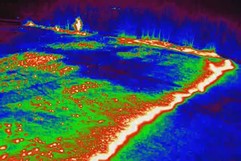
This image is taken over the Reed/Bryan fields of the Pole Farm. The large “T” shaped boardwalk and trail that connects to Twin Pines is in the background of the image, appearing dark purple. Federal City Road would be to the right side, beyond the picture. The fire is moving towards the right, so the areas to the left of the bright white fire line have burned already. What I found fascinating about this image was the temperature gradients of the fields that were burned just moments prior to this picture being taken. Wet areas, defined by the dark purple areas, behind the fire line are the same temperature of wet spots that have yet to burn. Between the tufts of still smoldering grass are varying sizes of cooled, cooling or unburned grassland. These blue and purple areas served as refuges for small mammals like rabbits, while meadow voles were able to retreat to their subterranean tunnels. This image demonstrates the effects of soil moisture and microtopography on prescribed fire behavior.
|
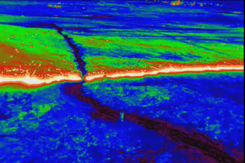
Another image taken over the Reed/Bryan fields of the Pole Farm; again illustrating the microdynamics of prescribed fire over the grasslands. The bright white horizontal line across the middle of the image is the active fire, above it grassland that had just been burned. The purple line bisecting this picture is one of the small streams that courses through the field with the “last pole standing”. Notice how the banks of the stream behind the fire line are blue again, and the lower and wet areas amongst the recently burned field.
As we continue to monitor the grasslands post burn, we look forward to sharing the ecological change taking place
|
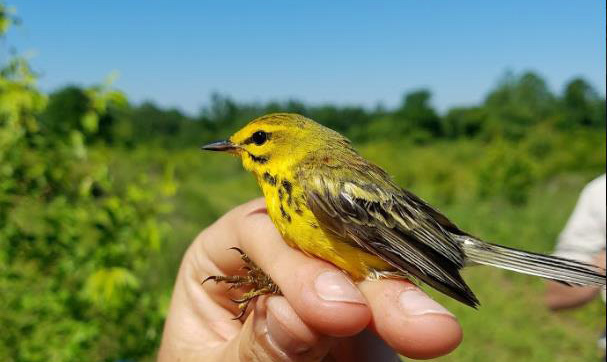
Try This! Backyard Birding
If you have children at home, or are looking for a quarantine friendly activity, consider investing in a bird feeder or making one out of items you already have in your home. A bird feeder can easily be made from a soda bottle. One or two songbird sized holes should be cut into the sides of the bottle, about two inches from the bottom. Just below the cap of the bottle, poke two holes through the neck and thread a loop of string through them to hang the feeder from a tree branch. Look online for some creative ideas.
Hang the feeder in a spot where it can be observed from indoors. Fill it with some birdseed and in time, the birds will arrive. When they do, challenge yourself or your kids to count how many different types of birds they see. Keep a daily tally. The variety of birds will differ depending on where you live and the type of bird seed provided, but birds will come. A few of the most common backyard birds are: American Robin, Blue Jay, Carolina Wren, European Starling, House Sparrow, Mourning Dove, and Northern Cardinal.

Looking for something more to do with your kids? Have your kids imitate some of the sounds these birds make.
For instance, the House Sparrow makes a sound similar to ‘chirrrp chirrrp’, and the Black-capped Chickadee says ‘chicka-dee-dee-dee.’ Here are some more calls you can try:
American Robin – ‘cheerily cheer up’
Red-winged Blackbird – ‘konkareeee’
American Crow – ‘caaw caaw’
Mourning Dove – ‘Coo-ah oooo oooo oooo’
Check out www.allaboutbirds.org for more bird information.
Remember to refill the feeder and provide fresh water daily!
|
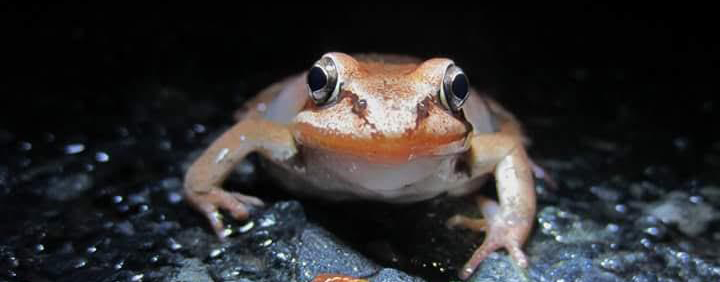
Finding Intimacy with Nature in a Time of Social Distancing
By Jillian “Sparks” Stark, Senior Land Steward
During this time, many people are finding themselves home and with more time on their hands than usual. For those essential workers out keeping the world turning, our deepest gratitude extends. But for the many of us at home, there is an opportunity to take a break from the news and get outside to explore and reconnect with nature.
This may be a time to become more intimately familiar with your own back or front yard than you have been before. Take notice. Spring is creeping in and you may find ephemeral wildflowers such as spring beauties or bloodroot blooming amongst the leaf litter. Flip over a rock or log (make sure you gently flip it back in the same spot!), and you may see salamanders keeping warm or insects at work.
Go for a walk - listen for spring peepers or maybe even wood frogs calling at their vernal pools. Watch the birds - are they seeming busier than they did a month ago? Take note of budding red maples providing that first splash of color, and even the greening of our non-native plants that comes before the rest.
Pulling out an old field guide or downloading the iNaturalist app on your phone may be a way to boost your knowledge and direct a distracted brain. In this time of social distancing, why not find a close friend in nature?
 Photo 1: Bloodroot flowering right next to a driveway.
Photo 2: Red-backed salamander under a log.
Photo 3: Spring beauties.
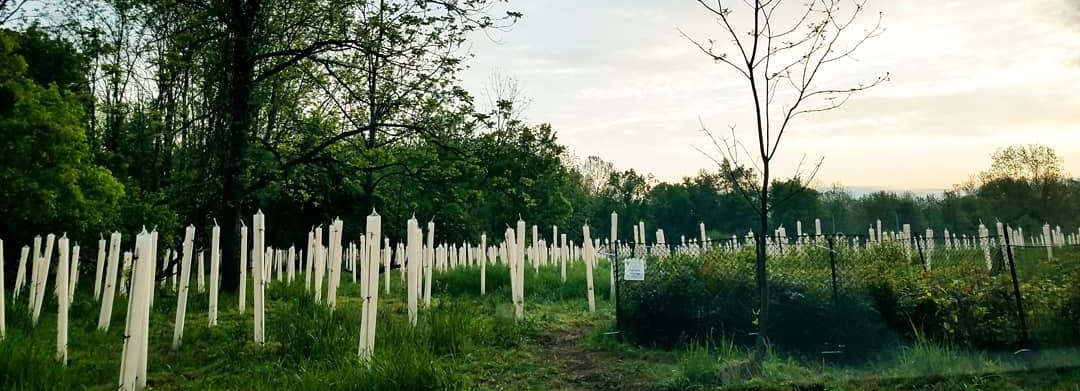 Photo by Bobbie Schwaeble.
Roots for Rivers Update
By Alex Rivera, Land Steward
Spring is usually a busy season for the stewardship team with multiple tree plantings, but not in 2020. This year, all of our planting energy will be focused on the Fall. Happy hours, dance parties, and other hangouts can happen virtually, but people-powered planting cannot. When it became clear that our spring season plantings would have to be rescheduled due to COVID-19, I thought about joy that is present when people come together to plant trees. More than once, a volunteer who is usually sitting in an office at 10 a.m. on a Tuesday, shares that they can’t remember the last time they felt so happy in the morning. New relationships formed among strangers and existing relationships grew stronger. I always learn something new and interesting about a colleague during a long day of planting too. Plants bring people closer!
In the fall, we have plans to expand our pollinator planting at South Riverwalk Park, perform several understory plantings in forest areas affected by loss of ash trees, and complete our Roots for Rivers restoration at Rosedale Park. These projects will result in nearly 2,000 native trees, shrubs, and wildflowers planted in the parks throughout Mercer County. All of these efforts will be completed by the hard work and many hours donated by volunteers. So much of our work, from plantings, to monitoring, education and outreach does not happen without the efforts of our community, and I, along with the rest of our Stewardship Department, am looking forward to when it’s safe for everyone to participate in stewardship with us. I’m a little sad that our plantings needed to be postponed, but the productive exhaustion from a packed fall planting schedule will feel great. If you would like to be part of our community stewardship team when we resume volunteer programs, please email arivera@mercercounty.org.
Trex Challenge April Update
By Alexandria Kosowski, Teacher Naturalist
Have you been wondering if we came close to meeting our collection goal of 500 pounds of recyclable ‘plastic film’ before we needed to suspend the challenge?
When we started the NexTrex six-month challenge back in November 2019, we had no idea what to expect. We knew that people were aware of grocery bag recycling but Trex encourages people to recycle ‘Beyond the Bag.’ We thought this would be a good way to inform people of all the other recyclable plastic that is typically tossed into the trash. Ultimately, Trex uses this type of plastic to make their composite outdoor decking and railing systems. So as an incentive to participate, Trex promises to donate a bench to any program that meets the 500 pound goal within six-months.
Initially, the number one plastic film brought to us was the plastic grocery bag but that started to change. We began to see less grocery bags and more plastic mailers, fresh produce bags for carrots, potatoes and celery, in addition to bread bags, newspaper sleeves, and ice bags. It was a nice change.
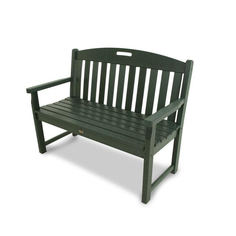
Many of you shared that you wanted to recycle the correct way. You took the time to collect the plastic film and you brought it to our drop off locations in order to help us meet our goal. If you dropped off your materials at the Tulpehaking Nature Center, staff ensured the collection was 100% contaminant free.
Frankly, the response was heartwarming.
So YES, we not only met our goal, we exceeded it in only four months! It is all because of you, our loyal ‘plastic film’ recyclers.
We thank you for caring for our planet and helping us earn a beautiful Trex bench.
Stay safe!
|

Emerging from the Smoke:
Direct Impacts of Prescribed Fire to Our Plants and Wildlife
By Cody Panek, Stewardship Technician
Fires are an ecologically significant part of the landscape processes that have occured for hundreds of thousands of years, both pre and post human arrival to North America. These fires are what drove the natural selection of fire-tolerant plants, allowing their offspring to become more resilient to fires. These fires also created a dynamic habitat for wildlife to live. What was once a meadow that over time became a forest would then be affected by a fire, reverting it back into a meadow, allowing the cycling of wildlife that are suited to those different habitats. Native Americans used fires for centuries in order to help control the plants of the landscape, and create an easier and more reliable food source. The prescribed fires that have been occurring for hundreds of years by people have both immediate and long-term ecological benefits to the landscape.
WILDLIFE:
The fires prescribed at Mercer Meadows burned at a low-intensity. The soil, even at the surface, remained cool as the fire traveled over top. As soon as the flame passed, our stewardship staff were able to feel both the temperature of and moisture in the soil. Rodents such as meadow voles create long and complex tunnel systems just under the surface of the thatch (dead plant materials) layer and burrows deeper in the soil. The prescribed fire was successful in the removal of the thatch layer, which did expose some of these tunnels. However, immediately following the fires, rodents were seen coming up from their burrows under the soil.
The deer that bed in the woods and meadows during the day were seen scampering off just as the fire started. Other mammals such as raccoons and opossums were not seen but would have been left unharmed as they are nocturnal and sleep up in the trees during the day, far above the fires that would have traveled through the woods. Amphibians are generally residing safely under moist leaf litter, or in wet areas of the land that would not burn.
Birds were able to flee during the fires, and eastern bluebirds, American robins, and savannah sparrows were spotted in the fields following the fires, foraging for newly exposed food sources. Northern harriers were seen soaring across the recently burned meadows in search of a meal and one was even spotted diving down a few times in an attempt to catch a rodent. We anticipate that the grassland breeding birds will benefit from the burn, as it controlled many of the undesirable woody plants encroaching in the grasslands. We are performing scientific monitoring on the subject to test this theory.
PLANTS:
Many of the woody invasive plant species that are found in the meadows such as Asiatic bittersweet and autumn olive were easily burned and top-killed (all tissue above the soil was killed). There is a chance that some of the invasives may come back during the growing season, but a selective follow-up application of a herbicide solution to the invasives should kill them for good, allowing more space for our native plants to continue to grow.
The dead tissues of our native grasses and wildflowers burned as fuel as well. However, since these plants are currently dormant, all of their energy storage is in their roots. These plants will emerge during the growing season as usual, and we expect even more native grasses and wildflowers to germinate due to the seed bank in the soil being opened up from the fire. Many of the dead trees and other debris found in the woods and meadows were burned up by the fire which will allow for more growth from other saplings. The prescribed fire is an excellent nitrogen fixer which will help add nitrogen into the soil allowing for more native plant growth. Overall, the first prescribed burn of Mercer Meadows was successful and will provide many various ecological benefits to the plants and animals that reside in our park.
Be sure to take a closer look outdoors during this time and we hope to see you all soon!
|